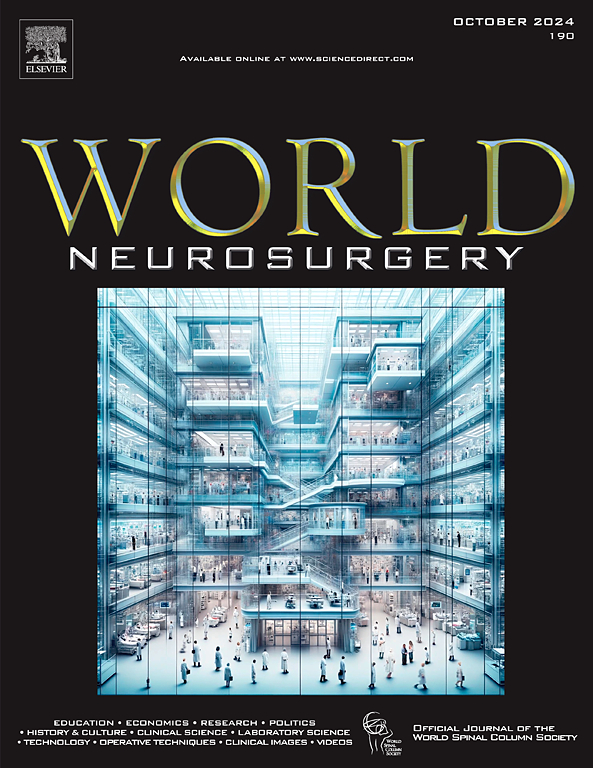Efficacy of Tailored Treatment Strategies for Chronic Subdural Hematoma Based on Hematoma Characteristics and Volume: A Retrospective Observational Study
IF 1.9
4区 医学
Q3 CLINICAL NEUROLOGY
引用次数: 0
Abstract
Objective
We assessed the effectiveness of a treatment strategy based on hematoma characteristics and volume.
Methods
From September 2022 to December 2023 (the Study period), a 2-center retrospective observational study of initial chronic subdural hematoma was performed. The baseline period was from January 2018 to December 2019. Patients were classified into the high and low retreatment rate groups (Groups H and L, respectively). During the Study period, Group H was treated with drainage and middle meningeal artery embolization, while Group L was treated with drainage or middle meningeal artery embolization alone. During the Baseline period, all the patients were treated with drainage alone. The primary and secondary endpoints were group retreatment rates and severe procedure-related complications requiring surgical intervention and permanent sequelae, respectively.
Results
Fifty-two patients were included during the Study period (31 in Group H and 21 in Group L) and 53 during the Baseline period (32 in Group H and 21 in Group L). Three (5.8%) and 9 (17.0%) patients required retreatment in the Study and Baseline periods, respectively (P = 0.12). One (3.2%) and 9 (28.1%) patients in Group H required retreatment during the Study and Baseline periods, respectively (P = 0.01). Similarly, 2 patients (9.5%) and no patient in Group L required retreatment during the Study and Baseline periods, respectively (P = 0.49). No severe complications were reported throughout.
Conclusions
Chronic subdural hematoma treatment strategies that consider to hematoma volume and characteristics have the potential to identify and reduce treatment rates in cases with high retreatment rates.
基于血肿特征和体积的慢性硬膜下血肿定制治疗策略的疗效:回顾性观察研究
目的: 我们评估了基于血肿特征和体积的治疗策略的有效性:我们评估了基于血肿特征和体积的治疗策略的有效性:从 2022 年 9 月到 2023 年 12 月(研究期间),我们在两个中心对初始慢性硬膜下血肿(CSDH)进行了回顾性观察研究。基线期为 2018 年 1 月至 2019 年 12 月。患者被分为高再治疗率组和低再治疗率组(分别为 H 组和 L 组)。在研究期间,H 组采用引流术和脑膜中动脉栓塞术(MMAE)治疗,而 L 组仅采用引流术或 MMAE 治疗。在基线期,所有患者都只接受引流治疗。主要和次要终点分别是组内再治疗率和需要手术干预的严重手术相关并发症以及永久性后遗症:研究期间纳入了 52 名患者(H 组 31 名,L 组 21 名),基线期间纳入了 53 名患者(H 组 32 名,L 组 21 名)。研究期间和基线期间分别有 3 名(5.8%)和 9 名(17.0%)患者需要再治疗(P = 0.12)。H 组分别有 1 名(3.2%)和 9 名(28.1%)患者在研究期间和基线期间需要再治疗(p = 0.01)。同样,L 组分别有两名患者(9.5%)和一名患者(28.1%)在研究期间和基线期间需要再次治疗(P = 0.49)。整个治疗过程中未出现严重并发症:考虑血肿体积和特征的 CSDH 治疗策略有可能识别并降低高再治疗率病例的治疗率。
本文章由计算机程序翻译,如有差异,请以英文原文为准。
求助全文
约1分钟内获得全文
求助全文
来源期刊

World neurosurgery
CLINICAL NEUROLOGY-SURGERY
CiteScore
3.90
自引率
15.00%
发文量
1765
审稿时长
47 days
期刊介绍:
World Neurosurgery has an open access mirror journal World Neurosurgery: X, sharing the same aims and scope, editorial team, submission system and rigorous peer review.
The journal''s mission is to:
-To provide a first-class international forum and a 2-way conduit for dialogue that is relevant to neurosurgeons and providers who care for neurosurgery patients. The categories of the exchanged information include clinical and basic science, as well as global information that provide social, political, educational, economic, cultural or societal insights and knowledge that are of significance and relevance to worldwide neurosurgery patient care.
-To act as a primary intellectual catalyst for the stimulation of creativity, the creation of new knowledge, and the enhancement of quality neurosurgical care worldwide.
-To provide a forum for communication that enriches the lives of all neurosurgeons and their colleagues; and, in so doing, enriches the lives of their patients.
Topics to be addressed in World Neurosurgery include: EDUCATION, ECONOMICS, RESEARCH, POLITICS, HISTORY, CULTURE, CLINICAL SCIENCE, LABORATORY SCIENCE, TECHNOLOGY, OPERATIVE TECHNIQUES, CLINICAL IMAGES, VIDEOS
 求助内容:
求助内容: 应助结果提醒方式:
应助结果提醒方式:


